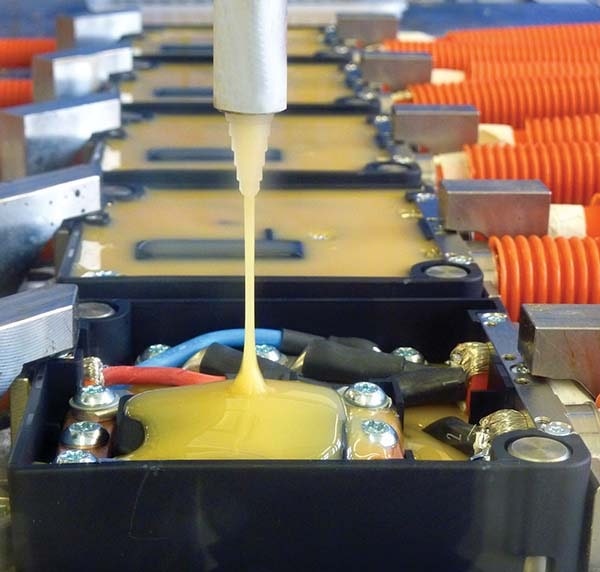What is potting compound | Exploring the challenges of potting compound in electronics
Potting compound, also known as potting resin or encapsulating compound, plays a crucial role in the protection and longevity of electronic devices. It is a material used to encapsulate sensitive electronic components within a protective shell, shielding them from environmental factors such as moisture, dust, shock, and vibration. In this blog, we'll delve into the types, characteristics, advantages, challenges, and applications of potting compounds in the realm of electronics assembly.

Types of Potting Compounds:
1. Epoxy Potting Compounds: Known for their excellent mechanical strength and chemical resistance, epoxy potting compounds are widely used to encapsulate sensitive components in harsh environments.
2. Polyurethane Potting Compounds: These compounds offer flexibility, making them suitable for applications where shock and vibration resistance are paramount.
3. Silicone Potting Compounds: Renowned for their high-temperature resistance and electrical insulation properties, silicone potting compounds are often chosen for demanding electronic applications.
4. Urethane Potting Compounds: Combining the advantages of epoxy and silicone, urethane potting compounds provide a balance of mechanical strength, flexibility, and chemical resistance.
Characteristics of Potting Compounds:
1. Mechanical Strength: Potting compounds must provide sufficient mechanical strength to protect electronic components from physical damage due to handling or environmental factors.
2. Chemical Resistance: Resistance to chemicals ensures that the encapsulated components remain unaffected by exposure to various substances.
3. Electrical Insulation: Potting compounds should possess excellent electrical insulation properties to prevent short circuits and electrical failures.
4. Shock and Vibration Resistance: Effective potting compounds absorb shocks and vibrations, safeguarding delicate electronic components from damage.
5. Air Bubble Elimination: Proper potting techniques must be employed to eliminate air bubbles, which could compromise the integrity of the encapsulation.
Advantages of Potting Compounds:
1. Environmental Protection: Potting compounds create a barrier against moisture, dust, chemicals, and other contaminants, extending the lifespan of electronic devices.
2. Enhanced Reliability: By encapsulating sensitive components, potting compounds reduce the risk of electrical failures caused by environmental factors or physical stress.
3. Improved Thermal Management: Certain potting compounds offer thermal conductivity properties, aiding in the dissipation of heat generated by electronic components.
4. Simplified Assembly: Potting compounds facilitate streamlined manufacturing processes by providing a convenient method for encapsulating multiple components in a single step.
Challenges in Potting Compound Application:
1. Proper Material Selection: Choosing the right potting compound for specific application requirements is crucial to ensure optimal performance and longevity.
2. Air Bubble Elimination: Entrapped air bubbles within the potting material can compromise the effectiveness of encapsulation and lead to performance issues.
3. Compatibility Issues: Some potting compounds may not be compatible with certain electronic components or substrates, necessitating thorough compatibility testing.
4. Potting Process Optimization: Achieving uniform encapsulation without voids or irregularities requires precise control of potting process parameters such as temperature, viscosity, and curing time.
Applications of Potting Compounds:
1. Automotive Electronics: Potting compounds are used to protect electronic control units (ECUs), sensors, and ignition systems from harsh automotive environments.
2. Aerospace and Defense: Critical electronic systems in aerospace and defense applications require potting compounds to withstand extreme temperatures, pressure, and vibrations.
3. Industrial Electronics: Potting compounds play a vital role in safeguarding industrial automation equipment, power supplies, and motor controllers from rugged operating conditions.
4. Consumer Electronics: Potting compounds are employed in consumer electronics devices such as smartphones, wearables, and home appliances to enhance durability and reliability.
Conclusion:
Potting compounds are indispensable in the field of electronics assembly, offering unparalleled protection and reliability for sensitive electronic components. By understanding the types, characteristics, advantages, challenges, and applications of potting compounds, manufacturers can ensure the robustness and longevity of their electronic devices in diverse operating environments. As technology continues to advance, the demand for innovative potting solutions tailored to the evolving needs of the electronics industry will undoubtedly persist. As a professional potting compound manufacturer and electrical insulating solutions provider, we would be pleased to advise you individually, and you are also welcome to send your inquiry to [email protected].


